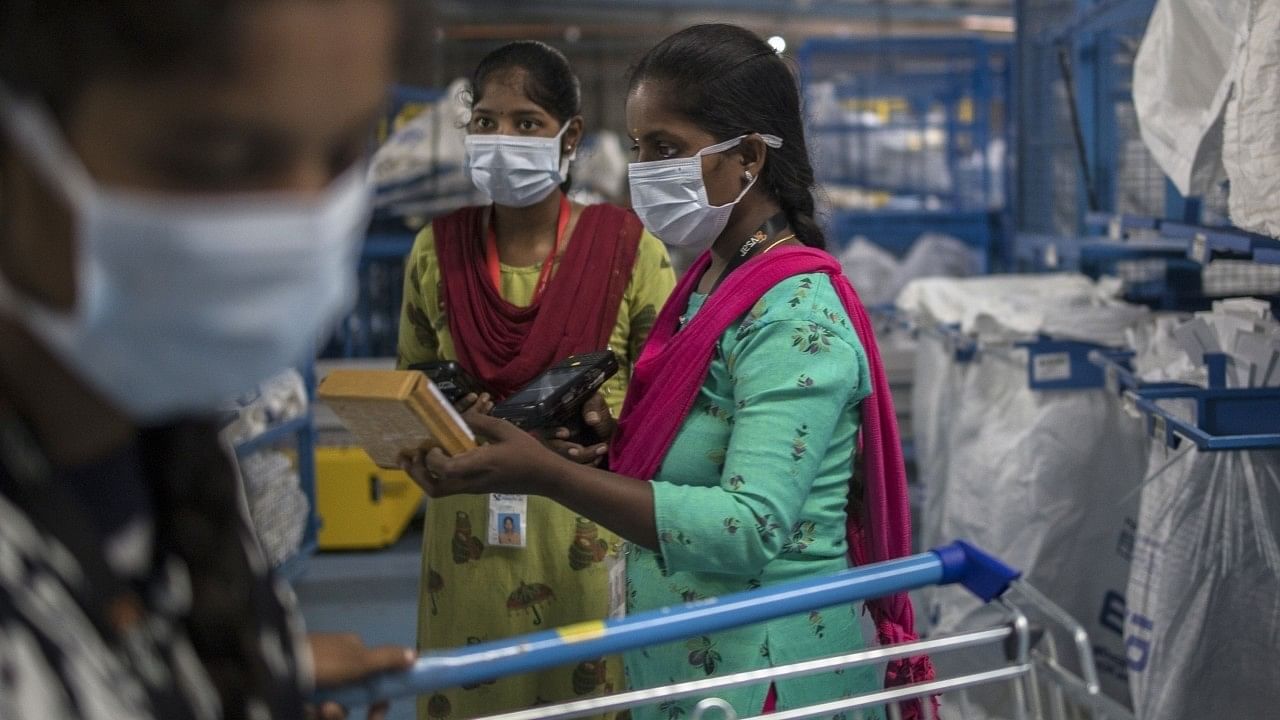
Representative image of women working at a factory
Credit: Bloomberg Photo
Claudia Goldin’s recent Nobel Prize in Economics has reignited a crucial conversation on female labour force participation (FLFP). Her work challenges the conventional notion of a linear relationship between economic growth and equitable gender participation in the workforce. Goldin’s U-shaped hypothesis posits that female participation in the labour force will be determined by the relationship between market wage and reservation wage, which is generally measured in terms of GDP per capita. The primary premise of the theory is that because men’s employment benefits from transition more than women’s work benefits, female participation rates are highest in poorer nations where women are involved in subsistence activities and lowest in middle-income (developing) countries. However, high economic growth, along with rising education levels, a decrease in the fertility rate, and a reduction in social stigma, facilitates women to reap the benefits of new job opportunities emanating from the service sector.
A woman’s involvement in paid employment serves as a vital indicator of her status within society. It opens doors to increased agency, mobility, and empowerment. However, in India, the history of FLFP has been marked by a consistent decline in participation, especially after the 1990s, when the nation initiated economic reforms. Regrettably, even as India aspires to become a $5 trillion economy, its performance in this regard lags far behind that of most other countries, a truly disheartening reality. According to the Global Gender Gap Report (2023), India’s performance in terms of economic participation and opportunities for women is dismal, placing the country among the five worst-performing nations worldwide.
Over the past 75 years, India has achieved several significant milestones that directly correlate with the increase in female labour force participation. Firstly, India has experienced remarkable economic growth. At the time of independence, the GDP was a mere Rs 2.7 lakh crore, but this figure has surged to Rs 234.71 lakh crore in 2021. Secondly, the gender gap in education is rapidly narrowing, with more women now pursuing higher education than ever before. Finally, there has been a dramatic reduction in fertility rates, dropping from 5.9 in 1950 to just two in 2023. This decrease has substantially reduced the time women spend caring for young children, allowing them more freedom to engage in other activities. Ironically, notwithstanding these accomplishments, India continues to face challenges in its endeavour to enhance the FLFP level.
Recent trends in female labour force participation indicate an increase in participation rates for both rural and urban women. Although a rise in women’s labour force participation is important for boosting their social and economic standing, not all forms of economic engagement lead to empowerment. Firstly, the rise in FLFP from 2017–18 to 2022–23 is driven by a substantial increase in rural women’s participation (41 per cent), compared to urban women (5.3 per cent).
Secondly, during the same period, the increase in FLFP is concentrated in the vulnerable self-employed category, while it has actually declined by 5 percentage points in the relatively more stable salaried employment sector. Thirdly, regrettably, India’s caste system still signifies disparities in wealth, and a detailed analysis reveals that the increase in FLFP is most pronounced among Scheduled Tribe (ST) women (18 per cent), followed by Scheduled Castes (SC) (12 per cent) and Other Backward Classes (OBC) (12 per cent), while women from upper castes show the least increase (7 per cent). These factors collectively indicate economic stress, with the rise in FLFP primarily being driven by economic necessity. Once this economic compulsion diminishes, many of these women may return to their homes.
In summary, Claudia Goldin’s work sheds light on the intricate relationship between economic growth and female labour force participation. In a rapidly changing global landscape, her research raises vital questions about the nature of work, gender dynamics, and the evolving role of women in the labour force. This acknowledgement underscores the pressing need for further research to spotlight these issues and promote gender-inclusive economic growth.
As India endeavours to empower its women and tap into their economic potential, understanding the nuances of FLFP is pivotal for shaping policies that encourage equitable participation. Achieving higher participation rates and gender equality in the workforce necessitates collaborative efforts from the government, civil society, the private sector, and a transformation in societal attitudes.
(The writers are PhD scholars at the Institute for Social and Economic Change, Bengaluru)